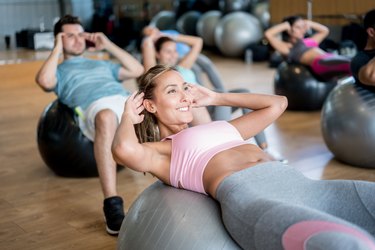
Whether you went to a mat class or had a session on the Reformer, chances are every muscle in your body got a good workout. That's reason enough for your muscles to be sore after Pilates.
If you're a beginner or you've taken some time off from Pilates, you can expect to have more soreness than if you've been doing it for a while. When it comes to building muscle and getting stronger, a little soreness after Pilates is a good thing.
Video of the Day
Video of the Day
What Causes Muscle Soreness
When you exercise, your muscles have to work harder than they normally do in your daily activities of living. In response to the load, the muscle fibers undergo microscopic damage. Although this sounds bad, it's actually how you build muscle and strength. Those tiny tears in the muscle fibers heal pretty quickly, and each time they go through the repair process they get a little stronger.
Delayed-Onset Muscle Soreness
You won't feel sore right after a Pilates workout. You might feel a little soreness in the evening, if you worked out in the morning. But chances are, you won't notice soreness until the next day. That's the effects of delayed-onset muscle soreness, or DOMS, and it's a common result of many types of physical activity, from strength training to hiking.
DOMS usually develops 12 to 24 hours after exercise, as your muscles begin repairing themselves. A lot of that repair process happens while you sleep, which is why it's common to feel muscle soreness and stiffness upon waking the morning after a tough Pilates workout.
Read more: Top 10 Pilates Exercises
Degrees of Muscle Soreness
A few variables will affect whether you feel sore the next day and how sore you are after Pilates. A new exercise routine exposes the muscles to stressors they're not used to. That can make you mighty sore the next day, especially if you went wild with your first Pilates workout.
Switching up your routine and doing new Pilates moves you've never done before may use muscles that haven't previously been used. As a result, those muscles will feel sore the next day.
Increasing the resistance on a Reformer machine increases stress on the muscles, which causes further damage. Even if you've been doing the same moves, adding more resistance can cause soreness.
Good Soreness vs. Bad Soreness
Some soreness after Pilates is a good thing. It's telling you that you've pushed your muscles just that little bit needed to cause them to change and grow stronger. You might not feel sore every time you work out; your body actually develops a protective mechanism that helps reduce soreness from doing a certain activity in the future. But each time you change up your Pilates workout, try a new piece of equipment or really push yourself more than before, you can expect some soreness.
But you know what they say about too much of a good thing: If you're so sore the next morning that you can't get out of bed, you've overdone it. You should never feel so sore that it interferes with your ability to go to work or school or take care of your family. That's a sign of severe DOMS, and that's no bueno.
Severe DOMS has other side effects besides debilitating muscle soreness. Your muscles might become swollen and tender to the touch. Joint stiffness, reduced mobility and muscle weakness are other signs of severe DOMS. Really severe cases can actually cause muscle breakdown and kidney problems. While these severe symptoms are more likely to happen after an intense weightlifting workout than a Pilates class, it's still important to know the signs.
Prevention and Treatment
A little muscle soreness when starting Pilates or changing up your routine is unavoidable. And, if your goal is to get stronger, it's not something you want to avoid. The soreness should go away with two or three days, and your chances of experiencing it again are reduced.
If you went too hard and you're experiencing more intense pain, it might take a few extra days for the pain to go away. The best thing to do is rest and don't workout again until most of the soreness goes away. Working out when you're still feeling sore isn't doing you any favors — it will break down rather than build muscle.
There's no way to shorten the duration of DOMS, but some things can temporarily reduce the pain. Light activity, such as a brisk walk, can provide temporary relief because it promotes blood flow to the muscles. After you've warmed up with light activity, you can do some gentle stretches for particularly sore muscles, or use a foam roller to help tight muscles relax. Getting plenty of sleep, hydrating well and eating nutritious foods will also help your muscles heal and support your body for future Pilates workouts to come.
Read more: 10 Surprising Benefits of Pilates